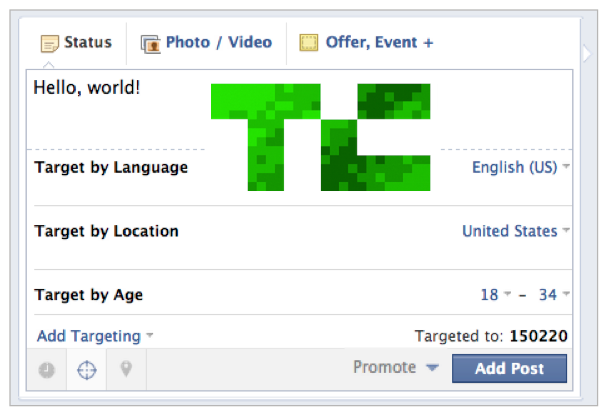Content Context is King!
Social media ushers in an era of contextual relevance that finally trumps content as king. Don’t get me wrong, content is important. After all, without it, what would people read, watch, interpret, remix and share? But without context, content is simply a message or story trying to find a home. In social networks, people stitch together social networks based on their relationships, interests, and aspirations to personalize their online experience. Doing so creates a network where, in theory, information that’s shared and the connections that come and go are material to everyone involved.
If relationships form, in Facebook lingo, the social graph, then the idea of connections based on relevance form the interest graph. And, it is the interest graph where context serves as the future of marketing and customer engagement. Using traditional marketing lingo, it’s the difference between targeting customers through demographics (age, gender, education, etc.) and psychographics (interests and commonalities).
Demographic targeting is typically aligned with the marketing funnel of which advertising pours its hopes and ideas. Because of the contextual nature of relationships and conversations in social media, marketers need to rethink their approach. Why? Because the game is moving away from metrics that measure clicks and eyeballs to click paths that deliver intended experiences and outcomes.
It’s the move from eyeballs to lit up foreheads or to screen faces as my good friend Kare Anderson says.
Just in case I need to explain that one…digital marketers typically aim for eyeballs, stickiness, clicks and conversions among other actions associated with guiding a successful consumer journey from engagement to desired outcome. With eyeballs focused incessantly on social streams, the goal is to reach people without forcing them out of the flow. And if you do pull them from the stream, there must be a sense of value associated with the experience. The lit up forehead metaphor refers to basically everyone you see everywhere you go. You know, those people who are constantly heads down fixated on their mobile devices even in the company of friends and family. No matter where they’re at, whether it’s theaters, living rooms, trains, dinner tables, conferences, arenas, you name it, you can always tell who they are by their lit up foreheads. But, I digress…
No longer does it make sense to just buy ads against keywords or just locales. That’s the old way and it simply won’t work in Facebook or any other social network for that matter, Facebook recognized that marketers make decisions based on targeted segments and consumer interests. Facebook is also sensitive to the reality of social marketers that questions such as, “what’s the ROI?” are now as common as asking someone “how are you?” To help, Facebook introduced Page Post Targeting Enhanced, which opens up a myriad of demographic and psychographic lenses to see and reach different customers differently.

Source: Techcrunch
New targeting characteristics include:
– Age
– Gender
– Interested In
– Relationship Status
– Education
– College Status, Name, Major, Years
– Workplace
Techcrunch ran the following comment from a member of a closed Facebook Group for social marketers, “Today, we will start rolling out an enhanced version of Page Post Targeting to a small percentage of Page Admins. Over the next few weeks, this will become available to all pages. With this new feature, Pages can now target their posts to certain fans in the news feed who meet specific criteria such as age, gender, location, language, etc.
All content will still remain on the Page since this is the only way to allow friends of engaged fans who don’t meet the targeting criteria to see viral stories (i.e. David likes a post.. )”
This service is no magic bullet however. If you think about it for a moment, it further slices the overall reach of pushing ads at a general audiences, which to me, is like saying “social graph.” Instead, Facebook is pushing marketers toward interests combined with demographics to introduce contextual opportunities that are more relevant thus increasing the likelihood for engagement. Now, advertisers will have to expand not only their approach, but also their portfolio of advertising vehicles. Reaching each group requires a unique series of keywords, headlines, and supporting imagery to have a shot at earning attention. To do so requires new skills in addition to traditional media buying and research. New capabilities include keyword anthropology, dynamic creative design and the ability to revamp inventory to engage in real-time and at the right time, and rapid performance metrics (RPM) to measure and enhance initiatives throughout the campaign.
What’s your take on the news and how can advertisers improve how ads engage consumers while also driving desirable outcomes or clicks to action?
Originally published at AT&T’s Networking Exchange Blog
Connect with me: Twitter | LinkedIn | Facebook | Google+
The End of Business as Usual is officially here…







great message. context is deeper level.
Content is King……Context is the “Higher Power”
Content is data……Context is meaning.
Content pushes it out…..Context pulls you in.
ConteXt is the X factor. As in your own little private eXperience.
And when it can be delivered conversationally. Aaaaaah….that is service value unlike any other.
Well done!
Context is the soil, content the seed. You’ve got to have both for the magic to happen.
Great post, thank you briansolis.
Thank you!
Advertisers will recognize the value in Page Post Targeting as well as the diminishing returns in targeting overly niche/narrow markets. The ability to leverage Facebook’s big data on customers will increase confidence about the ROI for social advertising. However, while contextual opportunities may benefit from expanded advertising vehicles, advertisers will likely opt to expand their approach with minimal expansion of the vehicles. Practically speaking, advertisers can achieve increased targeted engagement for the same value of input/investment.
The way that Facebook, or other social media for that matter, allows you to divide your fans into specific demographics and areas of interest is its best asset for marketers. This new feature seems very similar to the way that Google+ allows you to post different messages to different circles and, if it works, will make it easier to reach exactly the people that you want to communicate your message to. The one area where Facebook has been struggling is in explaining these new features to their existing users.
Hi Brian,
I agree I also can’t hear that ‘content is king’ line another time. Facebook needs to get this because a few weeks ago Mark Cuban pulled 72 brands from Facebook for not getting this. Message context and content matter but diffinetely not manipulation of fans/likes.
They can learn from Amazon in the way they use data contextually otherwise its a popularity contest and no offense (Mark) but no one can win that.
Dara
Absolutely Dara. I’ve been toying with writing a response to Mark and others that miss the point about context.
I’m a social media analytics person and this article was really interesting to me because, as context becomes more important, it has a huge impact on how we measure, target, improve and develop our content and interactions with the audience. Ultimately, I can’t see it changing the ‘return’ data like how many people actually read that article or shared that tweet or downloaded software – but I can see it having a huge impact on the ‘development’ metrics that we use, going from the demographics (age, location) to also include interest topics and design impact. The term “keyword anthropology” is awesome, by the way.
Great. Freaking. Post. I’ve been harping on this same message for some time now and completely agree with what you’re saying
People make connections on Facebook for all sorts of reasons, and more commonly with total strangers based on shared interests in a product or service. Even companies are enhancing the shopping experience by promoting social discovery. They’re allowing users to follow individual products and product categories, allowing for direct updates in their newsfeed.
Facebook’s “open graph” system is allowing brands and retailers the unique opportunity to learn about the interests of their customers and use this information to serve them with personalized experiences.
yes! i’ve studied this and I *think* i’ve written the first report documenting the interest graph a few years ago!
Glad to see this feature getting more publicity. I’m always shocked at how few community managers use this feature. Facebook also doesn’t help by not properly educating page owners & using different terminology other than “post privacy gating” to explain the feature. Not to mention the horrible name in the first place.
Here’s a case study on how I recently used it on one of my pages:
http://www.outspective.com/social-media/how-to-improve-facebook-edgerank-using-this-hidden-feature/
Face book is changing the game now, and squeezing out the small businesses.